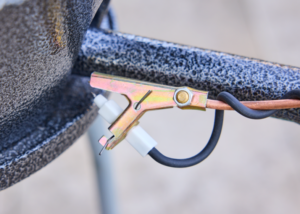Customer (PF13LQN120):
I have some questions/concerns about my wok burner. Inside the stand on the corner of the three support pieces that hold the wok up, it appears that the coating that covers the metal is burning off.
I don’t know what the coating is, the sort of grey texture that’s on the surface has turned white and ash like in that area. When I use the stand for an extended period of time (5-10 for a big batch of something or multiple batches) it seems to get worse and there is a bad smell coming out of the inside like fumes.
I’m concerned these fumes are unhealthy and may be dangerous, they don’t smell good, or could end up transferred into my food.
I have attached some pictures to try to show you the problems areas. Please advise whether this is normal.
I have only ever used a carbon steel wok on the burner. I have the natural gas version. It doesn’t really look like it’s something being deposited onto the area but that area burning. If I use it for a while and then take the wok off I can see some fumes coming from that area.

Outdoorstirfry:
The white area is where the flame touches the stove. No paint can survive direct flame. The paint will eventually be burnt off. Paint burning generates smoke. The smoke should go along bottom of the wok and up. It will not get into your food. Please stay away from the smoke such that you don’t inhale it. Once the paint is fully burnt off, the smoke should stop.




